Increase Conversions with Personalization Campaigns
If you’re striving to implement personalization marketing but aren’t sure of the best tactics, this article is for you.
Marketers have long understood personalization as a surefire way to increase conversions. Offering products or services in a targeted and familiar fashion drives consumer action unlike anything else.
Why? Because your users like to feel special. We all do.
With 60% of marketers struggling to personalize their campaigns, the field is wide open for those willing to strategize and embrace new technologies that enable increased engagement and higher conversion rates.
We’ll address the key differences between behavioral and lifecycle campaigns before discussing relevant strategies for multiple personalized campaigns, such as mobile push notifications, mobile banner ads, web content and more.
When you’re done, you’ll have all the information you need to reach customers on a 1:1 level and increase conversions in the most engaging way possible.
What is Campaign Personalization?
Personalizing campaigns is part of the larger push towards personalization marketing, the ideal form of targeted marketing. This is most often an automated, triggered process that uses a software stack to reach consumers at appropriate stages in their buyer’s journey. This involves individualized messaging across multiple channels to develop stronger customer relationships around responses received from targeted outreach.
Users are willing to trade personal information for personalized experiences. Brands can improve UX while providing value to their customers, so long as they’re tracking actions in efforts to personalize campaigns. To create effective targeted messaging, marketers must draw upon all relevant touch point data to deliver optimized messaging.
Why Does Campaign Personalization Matter?
Well, because many customers aren’t getting the service they want. A Lytics survey found that 80% of consumers said that brands are not familiar - or only passingly familiar - with their needs.
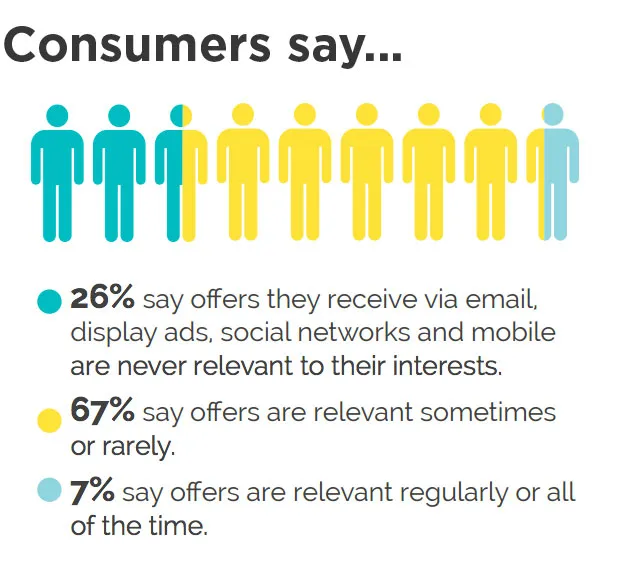
We’ve all walked into a brick and mortar store full of interest and been entirely ignored or disregarded to the point of not making a purchase. All it would have taken to make a sale was an involved salesperson facilitating a better in-store experience. Using this example, imagine campaigns personalization as the end of those times users come across your brand and walk out the proverbial store - or away from that conversion. Because now you’re speaking to them when and how they want to spoken to.
In an article for Marketo - Jeff Shjarback puts it nicely:
"By personalizing marketing messages and engaging audiences emotionally, it can help them to commit and envision their lives with your product or company in it. Every step of the conversion funnel should prepare your customers to do business with your organization, and to feel as if the product or ad was exactly what they were looking for — or custom tailored for them."
A well-personalized campaign capitalizes upon the importance of using relevant information such as:
- Customer’s name
- Customer's preferred communication channel
- Referencing customer's history and current/anticipated needs
- Previous communication interactions
- Income
- Lifestyle
As well, it acknowledges consumer behavior, the want to feel valued as an individual, the want for a personalized experience. There is a fine line between personal and intrusive so always seek to highlight value while being tactful.
How Do I Start?
Segmenting users is the first step to ensuring your personalization efforts go the distance. Basic segmenting factors include:
- Name
- Age
- Behavioral data
- Gender
- Geographic area
- Interests
- Job title or company size
- Transactional data like past purchases or purchasing frequency
- Associates who use your product or service
Beyond this, brands should be aware of where prospects fall along the awareness, consideration, and decision processes within of the customer journey. When and how prospects become customers can also directly affect how to address users in the future. For example:
- Subscribers that joined during a purchase are ready to receive upsell and cross-sell offers
- Subscribers that joined a newsletter via your blog are likely very informed about your offering
- Subscribers that arrive from social are primed to share news with friends
Segmenting by stages of the buying cycle is hugely helpful as well. For example, a customer may not return to your web page after purchasing because they’ve made their informed decision. At this point in the lifecycle they don’t need any more blog articles. Email and web page notifications could easily fall flat. But they user be receptive to push notification promotions or social media advertising at the right time, as they’re already a happy customer.
What is a Personalized Lifecycle Campaign?
The customer lifecycle refers to the milestones in the shared path that customers follow over the course of a relationship with your brand. Lifecycle campaigns reach users at distinct stages from early to mid to late phases of their relationship with the brand.
Lifecycle targeting is based around time intervals, such as an amount of time after an app download or three-day follow up after purchase. Messages are triggered after a set period of time. Example times for lifecycle targeting include:
Post-Signup
- Welcome series
- Feature update
- Member-to-customer conversion
- Cart abandonment
Post-Purchase
- Single-time buyer series
- Cross-sell
- Loyalty/ birthday
- Replenish or renew contract
- New product
- Win-back
Email Lifecycle Campaigns
Email lifecycle campaigns are a popular choice for marketers. A MarketingProfs survey saw 78% of brands performing lifecycle email welcome programs, while only 45% used post-purchase programs. 44% used cross- and upsell programs while only 26% used cart abandonment programs.
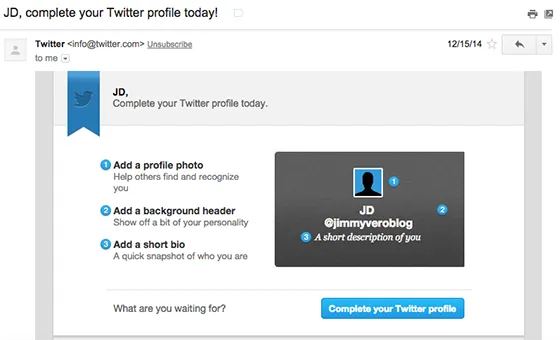 (Source)
(Source)
App abandonment is very real, as Twitter knows. This onboarding email is one in a time-sensitive series, spaced out to encourage users to set up the app and start engaging. With actionable copy and simple steps the recipient is guided towards the CTA to make it official.
Keeping up the momentum users have when signing onto a product or service is a fundamental function of lifecycle campaigns. How you create space between messages depends largely upon your segmentation and your user history.
Email lifecycle campaigns aren’t great for delivering time-sensitive information. Accroding to Zipsirep, the avergae email sits for 6.4 hours before being viewed. When it comes to sending messages of any kind, syncing the send-time with the user timezone can increase response rates in a huge way.
Moving beyond the “We’ve missed you!” messaging, try out lifecycle campaigns across platforms to reach users in ways that provide value. Experiment with incentives that are non-financial, such as free upgrades, sneak peaks or a free consultation.
What is a Personalized Behavioral Campaign?
Behavioral campaigns are triggered through some form of customer behavior. The actions and behaviors your audience has taken in response to your brand should determine the messaging they receive.
Anything from form submissions, social media activity, email engagement, website activity, and date for your other softwares must be considered when targeting users. Examples of behavioral actions worth targeting include:
- Newsletter Signup: target with welcome messaging
- Content Downloads: target with additional content
- Cart Abandonment: target with discounts and promotions
- Social Media Engagement: target for referrals and prompt additional shares
- Ad Clicks: tagrge with incentives and social proof
- Referred Customers: target with referral rewards
- Purchases: target for upselling and cross-selling and surveys
- Periods of Inactivity: target with re-engagement messaging
Behavioral Email Campaigns
Triggered email works very well for all the above actions. Overall, trigger emails show a 152% higher open rate than standard emails. This is due to the personalized nature of the emails as well as the relevancy of the messaging.
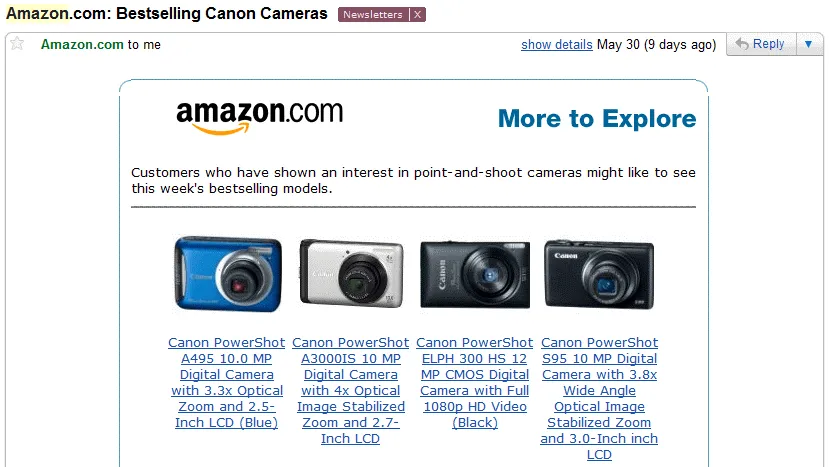
(Source)
This is a prime example of a behavior email campaign from Amazon. Users that have shown interest in digital cameras are sure to receive a targeted email suggesting a handful of viable options. The subject line deftly uses social proof as it recommended the “Bestselling Canon Cameras” and this theme is supported in the body copy. Amazon doesn’t overwhelm readers with too many choices, but remains relevant by mentioning that these are this week’s bestselling models and deserve immediate attention.
Now let’s look at some different types of personalized campaigns you can run according to a behavioral or life cycle strategy.
Personalized Web Content Campaigns
Aligning personalized emails and other messaging with personalized landing pages really maximizes conversions. Creating custom landing pages and URLs is worth the extra effort in terms of making a great first impression (or re-making one). Most of the time, personalized web content is part of a larger behavioral strategy.
Greeting customers with a friendly face rewards them for visiting your webpage and encourages their return, whether for blog materials or a purchases. This feels good like showing up to a party where the guest knows your name and makes introductions on your behalf.
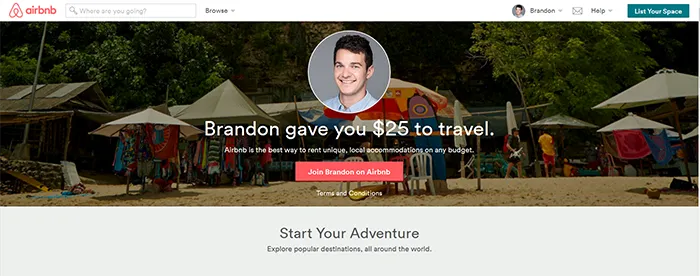
(Source)
This Airbnb personalized referral campaign is a winner, from the hero image to the thumbnail of a friend and into the copy. The referral greeting creates a unique experience in the viewer’s mind, something very rare when approaching websites. Users are immediately incentivized to start enjoying Airbnb with a bold CTA button. This actionable language follows a brief snippet about how their buddy Brandon has generously saved them some hard-earned dough - a social proof testimonial not many can resist.
Personalized Web Push Notification Campaigns
Web push notifications are clickable message sent by a website directly to the subscriber’s browser. These work on website themselves instead of apps and can be accessed from all devices, including desktops. Since desktop usage still accounts for 42 of total internet time this is a nice way to expand reach.
The purpose of the copy will be to get subscribers to click, so value for the subscriber is priority one. These campaigns require an instant response since they appear prominently in the upper right corner of the screen. Whether tied to behavior triggers like purchases or lifecycle stages like cross-sells, these are an effective means to reach users in time-sensitive fashion.
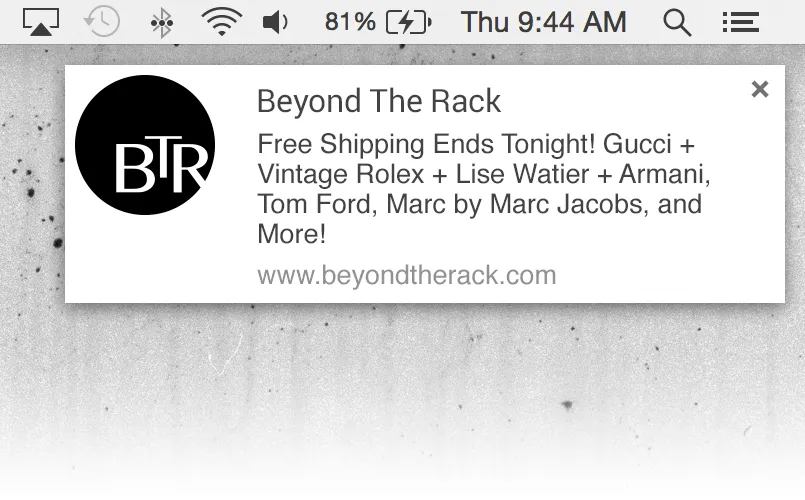
This Beyond the Rack web push notification brings subscribers the the timely promise of top-name brands with free shipping. Driving engagement with discounts is great for bringing users back around after time away. The logo usage is an important branded touch that helps improve recall.
Personalized Mobile Interstitial Campaigns
Interstitial ads are delivered inside an app and require immediate attention from users. Given that these full-screen ads block out other app content, it’s best to send these sparingly and with great value at the time of use. By overtaking the whole mobile screen, these ads make use of the limited space and routinely net high conversion rates. Some users will find these messages an undue hindrance to their experience, forcing them to click the “X” before resuming use. Use with caution, as too many of these can result in app uninstalls.
 Ecommerce retailer Wayfair employs mobile interstitial ads to engage users across behavioral and life cycle triggers. Offering promotional discounts and reminding users of value to their service, the company presents viewers with charming scenes available through product purchases. Superb photography is the key to conversions and is well supported here by a bright, cleanly branded aesthetic that helps users imagine themselves as customers.
Ecommerce retailer Wayfair employs mobile interstitial ads to engage users across behavioral and life cycle triggers. Offering promotional discounts and reminding users of value to their service, the company presents viewers with charming scenes available through product purchases. Superb photography is the key to conversions and is well supported here by a bright, cleanly branded aesthetic that helps users imagine themselves as customers.
Personalized Mobile Push Campaigns
These push notifications land in the notification tray of your mobile device home screen, displaying even when home screen is locked and the app sending the message is closed. Because mobile push notifications arrive in a highly visible location, response rates are reported to be 50% higher than out-of-sight emails.
This is a real-time form of communication, relevant for behavior and life cycle uses. Since push notifications require a user opt-in at the time of app install (or take a trip to preferences later), it’s important to respect the permission-based relationship between user and app notifications.
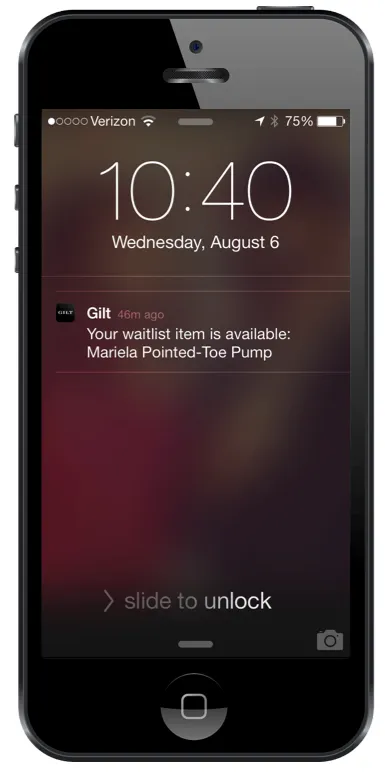
Fashion retailer Gilt keeps their push notifications behavioral in this campaign, updating users when sought-after items are available for purchase. Copy space for push notifications is tight and this online retailer makes good with concise and descriptive messaging.
Because unwanted correspondence could be deemed invasive, Gilt is careful to make sure messaging is hyper-relevant and personalized to drive conversions. Sending users an update about a favorite brand’s release of new products would go well here as well.
Personalized Pre-Filled Forms
Both a way to enhance UX and improve engagement, proving pre-filled forms for messaging is always appreciated by your audience (proving you’re not creepy with your auto-fill boxes). Personalizing this way speeds along conversions by cutting out steps and saving users valuable time in their day.
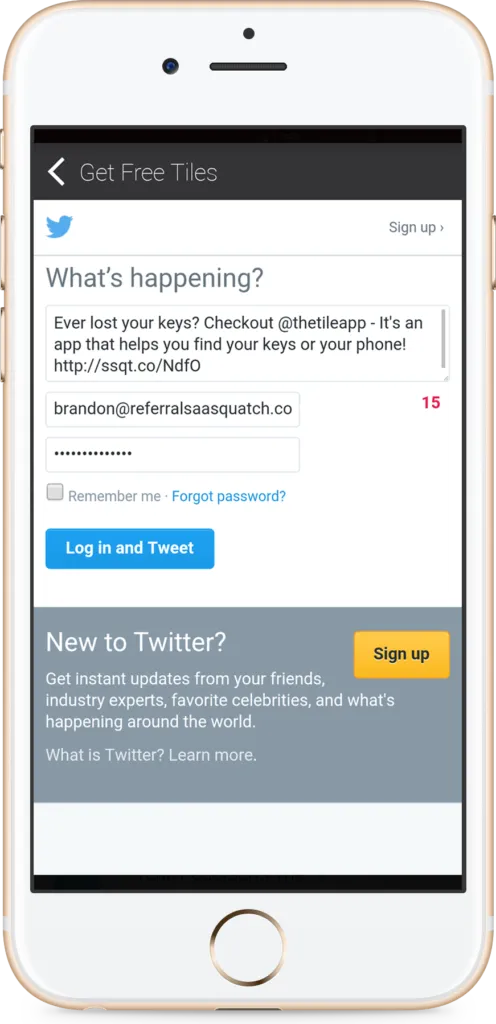 Wearable device company Tile shows us how to personalize for maximum effect. Within their strong referral program the brand makes sharing their service with associates a breeze on Twitter. User name, password, and the messaging have been filled and are ready to go - all that’s left to do is convert with a tweet.
Wearable device company Tile shows us how to personalize for maximum effect. Within their strong referral program the brand makes sharing their service with associates a breeze on Twitter. User name, password, and the messaging have been filled and are ready to go - all that’s left to do is convert with a tweet.
Your Key Takeaways
We’ve just looked at variety of personalized behavioral and lifecycle campaigns. Lifecycle campaigns are structured around time intervals, triggering upon a set schedule. By contrast, behavioral campaigns are triggered by actions (or inactions) taken by your users. Each discussed personalization campaign message type can be used for lifecycle or behavioral fashion - be it web push notifications, mobile push notifications, mobile interstitial, and personalized web content.
Based upon your brand and user segmentation, choose the style of messaging and the scheduling format that you think your users will appreciate most. A/B testing copy and campaigns themselves is highly recommended, as consumer preferences are variable and deserve due respect.